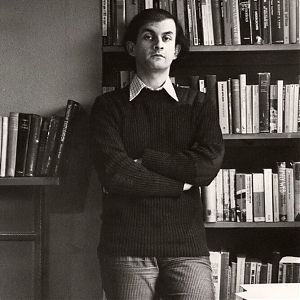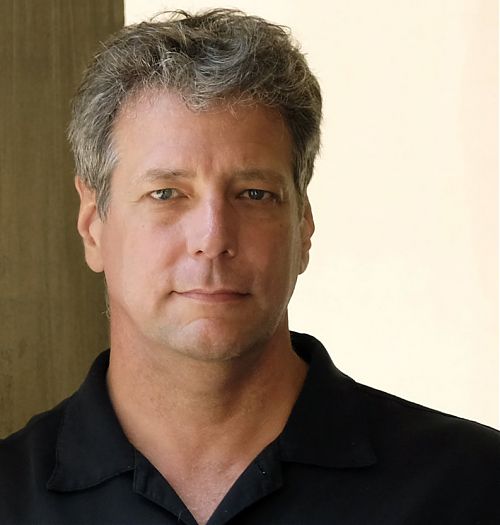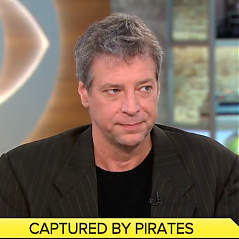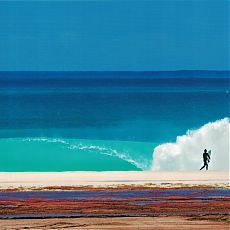Noah and the Dinosaurs
Mike finds a leader of the Intelligent Design movement in a compromising position.

September 2005
One rule of fundamentalists is that they hate to be interviewed. William Dembski doesn’t. He has a long face and glasses, wears knife-edged slacks and sober ties; he mixes fashion sense with a relaxed wonkishness that announces dedication to reason rather than the Bible-thumping fanaticism he’s been accused of at Baylor University, in Texas, where he once led an anti-Darwinist think tank called the Polanyi Center. He talks to radio and newspapers and seems wholly uncontroversial. But Dembski is also a leading name in Intelligent Design, a young movement of scientists who want to question Darwinism and prove, if they can, that the universe shows evidence of creation by some transcendent mind.
Whose mind? They won’t say. Dembski gives whole lectures without using the “G-word.” His field is math and logic; all he wants to do (he says) is distinguish design from randomness in nature. His book “The Design Inference” offers a test for telling a random system, like weather, from systems that couldn’t logically develop without a master plan. The basic idea is to prove that a bird’s wing, or even a bacterial flagellum — never mind a human being — is too complex to evolve at random, the way Darwin proposed. Dembski and “Design” scholars in other fields, like the biochemist Michael Behe, accept that the universe is millions of years old; they’re Christians but not fundamentalists; they don’t think the earth was formed in a week. But they do believe Darwinism is a kind of liberal-humanist religion, with its share of orthodoxies, shibboleths, and myths.
I saw Dembski speak in 2001 at my alma mater, UC San Diego. UCSD in that year had the only student club in America devoted to intelligent design. It was called the IDEA Club — “Intelligent Design Evolution Awareness” — and its Web site invited atheists and believers, evolutionist professors and young-Earth creationists, Phys.-Ed. majors and Hindus — absolutely anyone — to come in and wrangle over Darwin. Their openness impressed me. Disagreement and debate were part of the fun, at least in their online manifesto. They just wanted to talk.
Sites like “The San Diego Humanist,” by contrast, published mean-minded, antireligious sarcasm. “We atheists and humanists and freethinkers have all been made to feel pretty much apart from the rest of the world around us, haven’t we?” a woman called Lucia K. B. Hall had said in a speech posted on the Humanist site in late 2000. Religious people see humanists as, “Aliens,” she declared. “Sci-fi horrors. Bug-eyed monsters. Multi-tentacled nightmares dripping green slime that want to rape their wives and husbands and eat their children.”
This kind of whining made me wonder if college in America had somehow changed. Fundamentalist Christians had gone quiet since the days of Reagan and the first George Bush. Maybe it was now humanists who were hateful and intolerant. Dembski claimed to be the victim of narrow-minded, materialistic thinkers who lacked the mental equipment to see his revolutionary theories in full color. Well, I thought, suppose he’s onto something? I’d read about a theory in physics — unrelated to Design — that said the universe obeyed laws from a simpler, lower dimension, like a credit-card hologram throwing a 3-D image from information coded on a flat surface. The universe, in this model, is a projection, which we can fully untangle only with information that (like God) lies off our empirical map. Maybe Dembski had something to contribute in this direction. I was charged with curiosity. On the morning of his speech, I boarded a plane for San Diego.
§
UCSD is built on the cliffs above Blacks Beach in La Jolla. It’s known for a world-class biology department as well as its collection of hyper-modern buildings. To me the campus works as a survey of bad ideas in concrete and glass from the last thirty years. It reminds me of La Défense, Paris’ modern-architecture ghetto. UCSD’s new engineering building even had a square glass arch that resembled the famous arch at La Défense. A neon installation called the Seven Deadly Sins, flashing names of virtues and sins in multicolored neon, was commissioned for the roof of the university theater — where virtue and vice were dramatized — but homeowners near the La Jolla Playhouse had complained, so now the words LUST and AVARICE and CHARITY flashed nightly over the heads of engineering students from the top of an earthquake-research building. The whole campus has this futuristic, thrown-together quality. It’s not intelligently designed.
A few miles east, in the near-desert town of Santee, a long, white, stucco building called the Institute for Creation Research squats along a barren frontage road. This is the North American headquarters of fundamentalist Creationism. Its faculty of Ph.D.-laden scientists and mathematicians all believe literally and cheerfully in Genesis and every other book of the Bible. They teach and promote Creation Science, which is not really science but an odd project to chop and reassemble scientific evidence until it agrees with the Bible. Job lived during the Ice Age, in the Institute’s view. Noah’s flood wiped out the dinosaurs. The scholars at ICR give weak support for these claims in a series of little fliers. They publish new research in non-peer-reviewed journals and invite school groups to tour their Creation Museum.
Dembski and his Intelligent-Design friends reject young-earth Creationism. So many critics have accused the I.D. movement of being Creationism in disguise (including the late Stephen Jay Gould) that Dembski and Behe and members of the IDEA Club have to repeat, over and over, that they’re not fundamentalists. “I do not regard Genesis as a scientific text,” writes Dembski, in what amounts to a position paper. “I have no vested theological interest in the age of the earth or the universe.” He agrees the earth is 4.5 billion years old and the universe about 14 billion. “Even so, I refuse to be dogmatic here. I’m willing to listen to arguments to the contrary.” Again, that open mind.
I’d arranged to meet both Dembski and the IDEA Club’s president at a campus café before the speech. The club president was an enthusiastic earth-sciences student named Casey Luskin, with short dark hair, heavy eyebrows, and a nervous beaming smile. He seemed pleased to meet me but a little put out. Dembski couldn’t make the interview. He’d been sidetracked to Santee for a casual talk with a group that was curious about his ideas. Did I have any extra time? Could I drive out there with him? Sure I could. We climbed into Casey’s clean white Jeep and headed east, toward the Institute for Creation Research.
Casey talked, and drove, in energetic bursts. I wanted to know why my alma mater had the distinction of being the only school in the nation to host an I.D. club, and Casey gave me the story. He and two friends had founded IDEA in May 1999 after Phillip Johnson, a father of the movement, came to speak on campus. The fierce emotion Casey saw in other students after the speech and during a parallel seminar called “Creation and Evolution” had convinced him the school needed a club. He said IDEA had already tangled, awkwardly, with a prominent UCSD evolutionist named David Woodruff.
“Really?” I said. Woodruff had been a professor of mine. “What happened?”
Sore question. He hesitated.
“I need to think if I want this to be out in the open. It’s nothing like — I feel like we did nothing wrong, in that whole situation, at all … But if this could turn into something against my professor, I don’t want that.”
I promised not to turn it into a new scandal. I was just curious. Woodruff was a formidable man. “I’ll probably talk to him,” I said.
“About this situation?”
“No, just about Intelligent Design.” I still had no idea what situation he meant. “What happened, though?”
He started to breathe heavily.
“Could you turn off the recorder for a sec?”
A year or so earlier IDEA had pamphleted Woodruff’s final Evolution lecture with a list of sharp questions about Darwinism. Woodruff took the list home and dismissed each question in a brief, brusque paragraph in a flier of his own, which he handed out after an exam and also gave (later) to me. It was Woodruff’s only encounter with IDEA. He didn’t care who wrote the questions, although he knew who’d founded the club. Still, Casey was skittish about connecting his name to an exchange of ideological cannon fire with a distinguished professor. So he clammed up in the Jeep. IDEA’s free-debate ethic had its limits.
§
Casey parked in front of the Institute for Creation Research. We found Dembski talking in a lecture room to a handful of Creationist professors, mostly potbellied men with glasses and large watches who could have been small-town sheriffs or aerospace engineers. They looked weary but genial, sitting in cramped chairs while Dembski stood next to a podium in his clean suit and fielded questions about Design.
A man I later identified as Duane Gish, a Creationist who’s assaulted Darwinism in public for decades, said he was impressed and pleased with Dembski’s work, though he did wish the young man would come around to a young-earth position. Dembski was noncommittal. The only ground he gave to such blandishments was, “I think we’re all committed to Design.” They shared stories about the bigotry of mainstream Darwinists; they chuckled over Phillip Johnson’s poison pen. (Johnson is a lawyer, not a scientist. His debating skills are considerable.) Dembski answered a few questions about his falling-out with Baylor University, and then the meeting broke up.
The Institute for Creation Research was a weird place for Dembski to be. Later it would surprise experts (like Woodruff) that I had seen him there. On the whitewashed office walls hung faded kitschy paintings of the Seven Days of Creation. The Museum dramatized each Day in a series of rooms that were like shabby theater sets. The idea was to make Genesis feel present, palpable. You started in a black chamber — “Day One: God Creates Heaven and Earth” — with murals of swirling stardust and a familiar planet. You moved on to other chambers showing the invention of light, the birth of plants and animals, and so on. The text for each Day questioned evidence for the Big Bang (among other modern ideas). Day Seven was a warm room with lush jungle murals where aquariums of fish and beetles and lizards surrounded you like cages in a pet store. This was Eden. The resident Serpent — a three-foot ball python with a branch to climb — lived in a corner tank, and hidden speakers piped in birdsong.
The next room showed the Fall. Under glowering red light and soft, discordant music a glass case gave a sample of all the junk and waste of the modern world: a broken test tube, syringes, a cracked rock ‘n’ roll record. Darwinism, in this world-view, had severed modern people from true Christian faith. We lived in an errant world created by God, and the universe, despite appearances, was ordered and complete; our lives, if we turned to Christ (and rejected everything from modern science and to the United Nations) had meaning.
The most amusing and least scientific room at ICR had a painting of Noah’s Ark, with not just all the mammals in wooden stalls but also, just visible over a wooden rail, the back of a stegosaurus.
Why? Well, Creation Scientists believe Noah must have tried to save at least a few dinosaurs, because giant lizards had no time to evolve, under a young-Earth scheme, before humans.
I saw most of this the following day, when I drove to Santee alone. In the hours before Dembski’s speech I was still confused. I’d never heard of Creation Research. I didn’t know the Institute was the base for a re-education project in America, with a network of Christian radio stations and lobby groups to promote Creationism and oppose Darwinism in public schools. “I don’t want to say they’re all Okies, or descended from Okies who came here during the Depression and brought their religion with them,” Professor Woodruff told me later in his office. “But that’s what happened.”
I still wanted to meet Dembski; I still took him seriously as a scholar. Casey introduced us on the Institute’s porch, and there was a tension I didn’t understand. Dembski was tightlipped. Casey apologized: “I just thought he’d like to see the Institute. And you said you could talk to him before the speech —”
“You should have told me he was coming,” Dembski said.
The trouble had to do with his remarks about Baylor. I was asked not to print any of them. But his Baylor controversy was old news. It was less interesting, in the end, than the simple fact of a man devoted in public to non-fundamentalist “Intelligent Design” spending quality time in Santee. William Dembski turns out to be the mild face of a movement that wants to change American schools for scriptural reasons; and I had caught him in flagrante with Creationists.
Casey was nervous as hell. On our way back to campus he said, “You’re not gonna print anything you heard in there, are you?”
So IDEA’s openness had hit a brick wall. But I still wanted to join Dembski for dinner. After swapping cars in a campus lot, and riding in a van full of Intelligent Designers to the place where I’d parked my car, I sensed that I wasn’t barred from dinner, but not exactly invited, either.
Dembski brought up the school’s architecture. To show I meant no harm, I mentioned my impression of UCSD as a kind of La Défense-in-San-Diego. It seemed like a simple remark on a topic far removed from politics, Darwin, science, or God. “One of the engineering buildings over on the other end of campus,” I chatted, “even looks like the big square arch in Paris.”
Morbid silence.
Okay, fine — maybe they’d never been to France. These things happen. We reached my car and I heard Casey whisper to his friend Nate, in the back seat. Nate was an Urban Studies major who belonged to IDEA out of sheer enthusiasm, an earnest-looking goateed fellow with a shaved head and large, cowlike brown eyes. He needed a ride to his dorm. I’d offered to drive him, although it meant being excluded from dinner. Maybe Nate and I could talk?
But when we climbed out of the van, Nate said he didn’t really live that far away; thanks anyhow, he’d just as soon walk. Everyone waved goodbye. The van drove off, and I found myself alone in the lot with nothing to do for two hours. I had — by careful design — been dumped.
§
One reason I.D. irritates so many scientists is that the project looks to them like a costume for the old Creationist agenda of bringing religion back to the schools. Dembski likes to cast himself as a simple researcher who doesn’t care whether Intelligent Design finds a place in high-school textbooks, but he also turns up as a featured speaker at symposia with titles like “Darwin, Design, and Democracy: Teaching the Evidence in Science Education,” where strategies for pushing I.D.-based alternatives to Darwinism are hashed out.
Phillip Johnson started his Design career (as well as the movement) with a popular book called Darwin on Trial, in 1991. Johnson is a lawyer, not a scientist, and in his first book on Darwinism he never argued for an alternative to evolution in public schools. He just wrote that the idea of random natural selection was nothing better than a myth fobbed off on naîve, unquestioning kids. Random is the key word: Johnson is a Christian who believes the existence of mind in human beings is a manifestation of God’s intelligence, not just the really cool but accidental result of random genetic mutations over time. He thinks the dominance of materialistic, anti-religious Darwinism in the public schools is a prime reason why American education and morals are in such sorry shape.
But he also crusades. By 2000, Johnson had published an open plan for promoting a God-centered science in school. His book The Wedge Strategy elaborates a now-infamous internal memo from the Discovery Institute that found its way to the Internet not long before the book itself came out. The Discovery Institute is a Christian outfit based in Seattle where Johnson, Dembski, and other Intelligent Design proponents are fellows. The memo reads, flat-out: “Discovery Institute’s Center for the Renewal of Science and Culture seeks nothing less than the overthrow of materialism and its cultural legacies.” Materialism is the great evil, and the “wedge strategy” challenges it on three main fronts:
Phase I: Scientific Research, Writing & Publicity
Phase II: Publicity & Opinion-making
Phase III: Cultural Confrontation & Renewal
Dembski’s research fits into Phase I of this plan; Johnson’s wily debates and public appearances fit into Phase II; and state-level or local campaigns for teaching alternatives to Darwinsim in school — especially Intelligent Design — belong to Phase III. When the Kansas State Board of Education removed the teaching of evolution from its mandatory schooling standards in 1999, and then restored it, in 2001, the debate was dogged at every step by Intelligent-Design advocates. When George W. Bush suggested during a campaign speech in 1999 that he saw alternatives to Darwinism which might be taught in school, he was almost certainly thinking of Intelligent Design. What amounts to a cutting-edge scientific theory — with no articles published yet in serious, peer-reviewed journals — had dodged the scientific establishment and become, in ten years, a popular movement that reminded its critics of old-fashioned Creationism.
The Discovery Institute’s memo explains the image of a wedge: “If we view the predominant materialistic science as a giant tree, our strategy is intended to function as a “wedge” that, while relatively small, can split the trunk when applied at its weakest points. The very beginning of this strategy, the ‘thin edge of the wedge,’ was Phillip Johnson’s critique of Darwinism begun in 1991 in Darwinism on Trial [sic].”
This image of a tree and a wedge can also be found, amusingly, at the Creation Museum. The “Fall of Man” room has a diagram of a tree, labelled “Philosophical Evolution,” that bears evil fruits called Abortion, Dirty Books, Drugs, Racism, Humanism, Cults, Hard Rock, Suicide, and Inflation (among other nasty things). The trunk of the tree is “Biological Evolution,” and an axe biting into it belongs to “Scientific Creationists.” The tree grows from the soil of Unbelief, and the whole diagram bears a motto from Matthew 7:18 — “A good tree cannot bring forth evil fruit; neither can a corrupt tree bring forth good fruit.” Whether or not the diagram works as a true expression of the modern world, it does show — in vivid caricature — what motivates Creation Scientists as well as advocates of Intelligent Design.
Postscript: When this was published in 2005, it was a bit of color to contribute to a raging U.S. debate over a squabble that started in Dover, Pennsylvania. The final section was added here for context.
Michael Scott Moore

Rafts of the Medusa
Why every day on the Mediterranean is a new scandal for Europe. For both Foreign Policy and Die Zeit.
California’s Attempt at Land Reparations
How land seized from a Black family 100 years ago may be returned. The Bruce’s Beach story from a hometown angle, for The New Yorker
Day of the Oprichnik, 16 Years Later
The novelist Sorokin, the president Putin, his man Dugin, and the war in Ukraine. For n + 1.

The Rushdie Narrative
Knife and the crumbling ground beneath free speech
There Must Be Some Way Out of Here
An essay on Bob Dylan, “All Along the Watchtower,” and Somali pirate captivity.
That Mystic Shit
The life of Lou Reed in two biographies

Cambodian Seafarers Talk About Pirates
Mike visits Cambodia for The New Yorker to talk about a harrowing shared experience in Somalia
The Muslim Burial
Cambodian hostages remember digging a grave for one of their own. A sequel chapter to The Desert and the Sea
The Real Pirates of the Caribbean
Adventure journalism in Southern California. A travel essay for The Paris Review.

Antifa Dust
An essay on anti-fascism in Europe and the U.S., for the Los Angeles Review of Books
Was Hitler a Man of the Left?
A book that helped Republicans in America lose their damn minds.
Ghosts of Dresden
The Allied firebombing of Dresden in 1945 destroyed the baroque center of what Pfc. Kurt Vonnegut called, in a letter home from Germany, “possibly the world’s most beautiful city.”

George Freeth, Biographed
The first academic treatment of America’s surf pioneer. Also, was Freeth gay?
It’s Called Soccer
Americans live on what amounts to an enormous island, defended on two shores by the sea, and we’ve evolved a few marsupial traditions that nobody else understands.
Tilting at Turbines (in the Severn River)
The morning was clear and cold, with frost on the church steeple and the cemetery grass. I had a quick English breakfast at a white-cloth table, in my wetsuit, and drove to Newnham, a village on the Severn River in Gloucestershire, parking near the White Hart Inn.

The Curse of El Rojo
I’d packed the car lightly — a bag of clothes, a bag of cassette tapes, a backpack of books, a few essential tools.

































